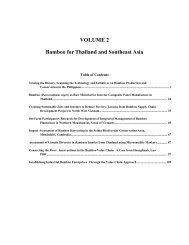WBC-VIII-Vol.4 – Resources – Forestry, Plantations and ... - BambuSC
WBC-VIII-Vol.4 – Resources – Forestry, Plantations and ... - BambuSC
WBC-VIII-Vol.4 – Resources – Forestry, Plantations and ... - BambuSC
Create successful ePaper yourself
Turn your PDF publications into a flip-book with our unique Google optimized e-Paper software.
determining culm weight is by physically weighing the dry culms, but this was not possible due to time <strong>and</strong><br />
logistical constraints.<br />
6) The estimated potential yield in tons (dry basis) per hectare per year was made with the assumption that, on<br />
average, 25% of the culms per clump are annually harvested. The figure of 25% or ¼ of the culms was used on<br />
the basis that only 3 year old mature culms are harvested <strong>and</strong> that new culms (year 0), as well as 1 <strong>and</strong> 2 year old<br />
culms are left to mature. There are variations in the number of new shoots that appear each year so the figure of<br />
25% is a working assumption. There may be years when fewer culms are mature <strong>and</strong> ready for harvesting, while<br />
in other years the harvest will be much greater. Clump management <strong>and</strong> maintenance as well as climactic factors<br />
play a leading role in productivity. In this regard, bamboo is not different from most other crops.<br />
7) Given the fact that the plantations are not well managed, it was assumed that the commercial yield would be lower<br />
than the potential yield. It was assumed that in a poorly managed plantation only 40% of the culms would be<br />
sellable.<br />
8) To compare the performance of the species in the KEFRI trials, collected data on the average physical properties<br />
of the culms of the species in their natural range in Asia was used for benchmarking. Averages of culm height,<br />
diameter, wall thickness, <strong>and</strong> dry weight culm in the KEFRI plantations were calculated <strong>and</strong> compared to the<br />
benchmark values.<br />
9) Analytic data per species <strong>and</strong> per location was sorted in order to rank the species in terms of three categories: (a)<br />
Estimated Potential Yield in Tons (Air Dry Basis) per ha/year; (b) Average dry weight of the culm; <strong>and</strong> (c) Height<br />
of the culm.<br />
Analyses of the KEFRI Bamboo Trials<br />
Abbreviations Used in the Analytic Tables:<br />
• H = Average Height of mature culms in Meters<br />
• D = Average Diameter of Mature Tapered Culms in Meters<br />
• WT = Average Wall Thickness in millimeters<br />
• DM = Estimated Average Air Dry Weight of Culm in Kilograms<br />
• AC = Average number of culms per clump<br />
• EY = Estimated Potential (air dried) Yield in Tons per hectare per year based on 5mX5m planting (400 plants/ha)<br />
with felling of only mature culms (25% of total culms) <strong>and</strong> extraction of dead or rotting culms.<br />
• CY = Commercial yield refers to tons per ha per year of top quality culms. 40% of Estimated Potential Yield (EY)<br />
is assumed.<br />
• RYS = Relative Yield Performance Ratio of a Species in Kenya. Each species with the highest Estimated Potential<br />
Yield (EY) is used as the basis for calculating the RYS ratio for the same species in different trial sites in Kenya.<br />
Thus, RYS = EY of a Species in Site X / EY of the same Species in the site where it obtains the highest EY. The<br />
RYS of the species with the highest yield in any of the various trial sites is therefore equal to 1.<br />
<strong>VIII</strong> World Bamboo Congress Proceedings Vol 4-120




